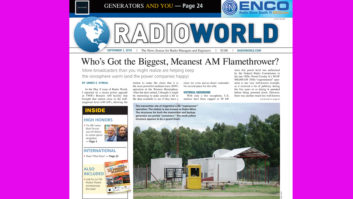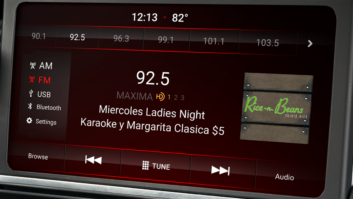The author is vice president of Edison Research.

AM/FM radio is dead! Everyone is listening to audio over the internet now!
Looking at some recent studies of the audio landscape, you might think that, or your advertisers might think that. However, if you take a closer look at how some audio research is being conducted, it should give you pause before you prepare your eulogy for AM/FM radio.
Edison Research prides itself on providing the audio industry with high-quality data that helps explain what people are listening to and why they are listening to it. One of the ways we do that is our Share of Ear product.
Share of Ear works to determine what people are listening to, where they are listening, and on what device they listen for both music and speech. It is the only product we know of that measures the entire audio space, including AM/FM (radio listening and listening to a stream of a station), streaming audio (Pandora/Spotify/etc.), owned music (CDs, vinyl, digital downloads), SiriusXM, music channels on TV, music videos on YouTube, podcasts, and any other listening.
Share of Ear has been conducted since 2014 and asks respondents to complete a 24-hour diary, entering for every 15 minutes if they have done any listening. It is updated regularly, allowing subscribers to spot trends quickly.
Various other companies produce estimates that dramatically minimize the size of AM/FM radio in comparison to streaming or other digital products. The following are two possible reasons why that is, and why you should make sure you dig deeper into data and how it is collected.
ONLINE-ONLY SAMPLES VS. ONLINE AND OFFLINE SAMPLES
A number of the estimates we’ve seen are surveys that were performed entirely online, which have the potential to bias results in a dramatic fashion.
Recently, we prepared a presentation for the American Association for Public Opinion Research (the preeminent organization regarding survey research) that showed that if you conduct a survey of online-only respondents, online behavior increases in ways that don’t reflect the total market.
Share of Ear is conducted online and offline, and we make the effort to include respondents who don’t have internet access or are not heavy internet users. Then we weight our data to make sure it properly reflects Americans’ internet usage. This allows us to represent the entire American 13+ audience, not just the Americans who use the internet or just those who heavily use the internet. To show how important this is, consider the total Share of Ear graph for only Quarter 1 2018.

We then ran an experiment removing all of the respondents who did not take the diary online; these are respondents who either don’t have internet access or used the internet for one hour or less in the prior 24 hours. When we did that, the results were dramatic.
Using this dataset, AM/FM listening decreases to 37 percent (a decrease of 16 percent) and streaming audio listening increases to 21 percent (an increase of 50 percent). Clearly the skewed (or incorrect) estimates that result from using an online-only sample would have a dramatic impact on how people view the audio landscape. Not including respondents in the sample who don’t have internet access or are light internet users will bias results and should not be relied upon when comparing AM/FM vs. streaming audio.
DIARY VS. RECALL
Share of Ear asks respondents to fill out a diary; this allows them to enter their listening in real time. Respondents do not have to think back to what they were doing or how long they were doing it.
When we have tested surveys that ask respondents to think back to how long they did something, we have found that they cannot provide reliable estimates. Respondents can tell you if they listen to a platform or what their favorite platform/AM/FM station is, but they struggle with remembering with precision how long they listen to various platforms.
If you are asking people time spent listening questions and trying to determine shares, it is best to ask it in a real-time diary product. Surveys that don’t should be viewed with a skeptical eye.
Even worse, we have seen surveys in which people are merely asked to report percentages of listening time, without taking into consideration how much time people spend in total. Thus a lighter listener is counted the same as a heavy listener — which is an egregious mistake when creating estimates of “share of time spent.”
Audio listening is in a constant state of flux, with new products constantly appearing and disappearing in the landscape. Streaming audio is certainly on the rise, and AM/FM needs to continue to take steps to become a bigger part of the streaming world.
Don’t forget though that AM/FM is, as of today, by a significant margin the largest audio or music platform in the total U.S. audio universe, and for now you should question data that says otherwise. When consuming data about the audio listening landscape, make sure you question how a survey was conducted, both in the way a survey finds its respondents and in the way the respondents are asked about how they consume audio.







